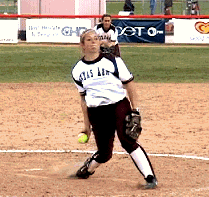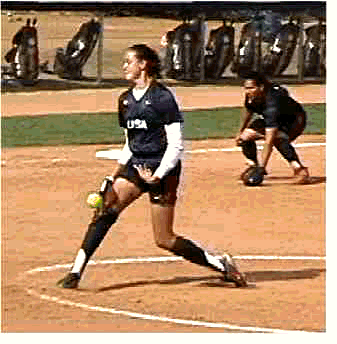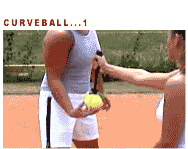|
by Gerald Warner, Softball Pitching
Instructor

"First I
learned how to throw a softball.
Then I learned how to throw it
fast and accurately.
Then I learned how to throw it slow but make
it look fast.
Then I learned how to spin the ball to make it go
down, up, and sideways.
THEN I was a pitcher.
...and that's when the work really
started!"

Many of the questions we receive from visitors to this
website are from pitchers who are trying to improve the
effectiveness of their breaking pitches…drop balls, rise balls,
curves, and screw balls.
Below is a recent e-mail received from a high school pitcher,
and our response.
FROM
W.N.:
“I am a high school senior and getting ready to go into my
third year of pitching. I have a fastball and I can do a rise ball
and a drop ball. My problem is my pitches do not have a lot of
movement until right before it hits the catcher's mitt, after it
passes the batter…Is there anything I can do to make my pitches have
movement enough to make my rise balls and drop balls more
effective?”
OUR
REPLY:
Your
problem is a pretty common one...the biggest difference is that your
recognize it and want to get it corrected.
Unfortunately, we have a lot of pitchers who brag about their 4
or 6 different pitches, but none of them work very
well.
With all
breaking pitches (drop,
rise, curve, screw, and all the combinations) the key elements are
always:
1) Correct direction of the
spin
2) Speed
of the spin
3) Velocity of the
pitch
There are 2 simple rules
for correcting soft break or "late break" problems:
a) Increase the speed of the
spin
b)
Decrease
the speed of the pitch slightly (for the drop, curve, and
screw...but NOT the rise)

Make
certain the spin of each pitch is right...the rotation is
going in the right
direction, and the ball is spinning rapidly. We see a lot of "rise balls"
that don't rise because they don't have the bottom-to-top
spin
(as seen by
the catcher), or curve balls that don’t
spin the right direction.
Obviously, a drop ball has to have a tight, fast
top-to-bottom spin.
My
primary recommendation is for you to work on developing an
off-speed drop. Keep your current drop ball and
continue working on improving it, but an off-speed version can be
very beneficial. The slower your hand goes through the
release point, the easier it is to impart a tight spin
precisely at the release of the pitch. This works
with either the peel or the rollover drop. If you have a
58 MPH fastball and a 34 MPH change-up, then a 43 MPH off-speed drop
can be a powerful weapon.
A tool that many pitchers use to
help generate wrist strength and flexibility is the TightSpin
Trainer. This "ball-on-a-stick" can be placed to
demonstrate which direction the ball must spin for each breaking
pitch, but also has an adjustable tension control to help pitchers
develop better spin speed.

Here is a link to the website
where you can find out more: www.fastpitching.com
The article
above can be downloaded and printed from Microsoft Word

Do you want to
reprint this article or use it on your website or in your
newsletter?
As long as it is not for profit,
our only requirement is that you first notify us, then include the
following sentence:
Article by Gerald Warner of
PitchSoftball.com
and include a reference to this
website: www.pitchsoftball.com
If
you have questions or need more information
E-mail us, or call Pitching Instructor Gerald Warner in
Colorado at (720)
200-4575
| 













